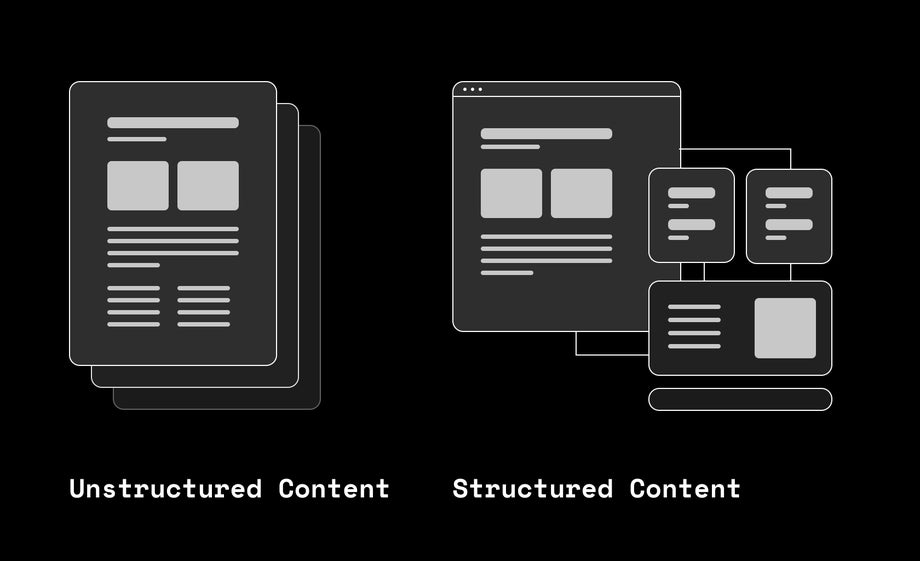

18.08.20236 mins read
Is structured content the only way for brands to effectively manage content today? With new platforms emerging all the time we know that it is getting harder than ever for brands to stay on top of content management. And consumers are not letting up- they expect that they will enjoy the same experience, the same content, regardless of channel. In short - today the importance of delivering information efficiently and consistently across multiple channels cannot be overstated.
However, there is a solution. Structured content. Which although is not exactly new, neither is it as commonplace as it should be, and from conversations I’ve had, is not fully understood.
To fix this, in this blog post, I will:
- Explore what structured content is.
- Provide examples of its practical implementation.
- Discuss the benefits of structuring your content.
- Highlight its role in enhancing omnichannel experiences.
So whether you're a marketer, a CMO, CX Director, or an eCommerce professional, the goal is to shed light on why structured content should be at the core of your content strategy.
The best way to think of structured content is to see it as a way of organising all your information- content- into modular components that can be easily reused and repurposed across your various channels and platforms.
It’s about shifting how we think about content and rather than treating it as a single large entity, we break it down into smaller, self-contained units, each with its metadata and tagging. These components can then be independently moved as required.

Again since the goal here is to make it easy to reuse or repurpose content across various channels the idea is that every bit of content is broken down into its smallest piece. So if you are an eCommerce company selling a wide range of products rather than having to compose product content for every item for each platform, instead you segment all your produced content and categorise it under headings such as specifications, features, benefits, and customer reviews. Then you start to slot the relevant asset into the required need.
I liken it to Lego pieces. Many of the bricks are interchangeable and can be used whether you are building the Titanic or Rivendell. Likewise, brands can use the same pieces of content across their websites, mobile apps, marketplaces, and more.
In addition, structured content is great for building up your frequently asked questions (FAQs) and knowledge base articles library. You can guarantee consistency and enhance the search functionality as each question and the answer becomes a separate component that can be assembled based on the user's context or query. From a tech perspective, it is then easier to search or filter this content when it's structured, rather than needing a more complex search.
As consumers get more digitally sophisticated the result is that often they are researching your brand first online before going into physical store. They might also be getting ads via their social media. If there are any price or description differences they will know. And this discrepancy can both damage your brand identity and negatively impact the buying decision.
As I mentioned earlier, we are now consuming content across an ever-growing selection of platforms. Keeping up with the scope and volume is a drain on resources both people and time. With structured content, you only have to create a piece of content once and then reuse it as needed. This not only reduces redundancy and duplication efforts, but it also streamlines content creation, localisation, and updates. All of which saves you time and resources.
As consumer preference for personalised digital experiences continues to grow, brands are under increasing pressure to deliver custom interactions. Again, this imposes significant strains on existing resources. However, by breaking your content into differentiated reusable components, you can more efficiently tailor the delivery of information depending on your customer’s likes, demographics, or location.
Thanks to Moore’s Law, the reality is that we can expect to see even more channels and platforms emerge in the coming years. Rather than seeing each new platform as yet another hurdle, implementing the structured content approach to your content creation will allow you to adapt and repurpose your existing content quickly. The net result of which is that you can have a faster entry into new markets or have a presence on the latest “hot new trend”.
The main takeaway here is this: structured content is the key to a seamless omnichannel experience. So whether customers are interacting with you via your websites, mobile apps, social media, AI chatbots, physical stores, or all of the above, by adopting structured content, you can ensure a consistent and coherent customer journey. This will enhance brand loyalty and drive conversions and increase customer satisfaction.

When we worked with Fáilte Ireland to redesign and redevelop their Visit Dublin website, we implemented a structured content approach to their content management. Now they can provide visitors with the same information across all their platforms and add new content easily in response to customer feedback or requests.
Finally, everyone from marketers to CTOs is under immense pressure to demonstrate their ability to pivot and adapt to each new tech trend. We want our clients to have this flexibility which is why we advocate a structured content approach. We take time to explain the rationale behind structured content and why it is the best approach for brands today and how it can unlock efficiencies in content creation and management, boost brand consistency, and create the exceptional omnichannel experiences that customers demand.

Learn how our creative and human-centred approach empowers Fáilte Ireland to grow domestic tourism


